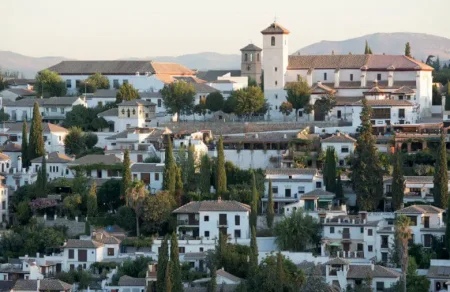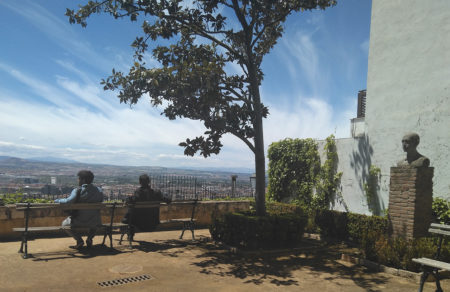Alice Guy, the first female filmmaker in the world, was in Granada and fell in love with the Sacromonte hill. She did it so deeply, that she shot the children of the gypsy neighbourhood. We can still enjoy theses frames, without them losing emotion and artistic quality, but Who was Alice Guy and How did she get to Granada? At Cicerone, we tell you her story, with the enthusiasm of working for a city that has been the birthplace and source of inspiration for artists from all over the world.
Índice de contenidos
Who is Alice Guy, a film pioneer in a world of men
There are people who accept what they are supposed to do. Others decide they own their lives. There are people who imitate those who are successful. Others prefer to learn and innovate. Move forward. Alice Guy belongs to the second group, to those who advance, despite the obstacles encountered along the way or the sacrifices that would entail. The freedom and the dream of doing what she really loved was worth it. But, for that, he had to find her passion first. That boost that changes your life (The Carmen at the Fundación Rodríguez-Acosta). And she found it.
Daughter of publishers, in 1895 she had already trained as a secretary. She worked in a photography studio in Paris. She was happy: she was autonomous and her boss appreciated her as a worker. One day, he asked him to accompany him to one of the private exhibitions that the Lumière brothers organized. Attending them was a privilege: it meant that you had a leading role in the city. The brothers sought to impress the most influential personalities, so that they helped them to popularize their invention.
Alice Guy accepted and that was a turning point. At that time, the cinematograph was synonymous with photography in motion. Not fiction, just people moving. Alice realized the potential that machine would have: it could be used to tell stories that spoke about the heart of people and that reached their souls. That same night, she asked her boss, lover of the avant-garde and partner of the architect of the Eiffel Tower, to buy a cinematograph so that she could learn to use it in her spare time. He agreed. She learned and invented cinema, the seventh art.
Alice Guy: the filmmaker and businesswoman who arrived at Sacromonte
During hes apprenticeship, she experimented and confirmed she was right: the Lumière brothers device would be a much more powerful means of communication if it was used for fiction, if the stories told had a narrative structure able to move the audience. In addition, the tape could be manipulated to create special effects that added spectacularism or, even, to explore science fiction and fantasy.
She was able to reach these conclusions on her own. However, to make them real, she would need to become an entrepreneur, find partners, people who would trust her idea, but also her. That meant getting into a world led by men and convincing them to support her in something that nobody had done before, Would she get it?
Of course. She had good contacts, as she had grown up in a liberal environment, and her conviction was unstoppable. The strength of his arguments was such, that it was impossible to resist them. She achieved what she wanted: she became a scriptwriter, director, editor, producer and actress of her films and travelled with them all over the world. He did not stay in Paris, he went to the United States, where they were astonished, and toured Europe. And, of course, she came to Granada, as did the most important writers, poets and painters of the 19th and early 20th centuries.
Filmmaker Alice Guy in the Sacromonte
If there was a historical place that dazzled those artists was the Sacromonte and the Albaicín hills. They saw in them something that was not found anywhere in the continent: the complete union of the Arab and Gypsy culture was touching and stunning, as if those people treasured a secret essence that linked them to their ancestors. Their bodies, the cobbled ground, the landscape, the caves, the first zambras were the incarnation of the last ten centuries. When you looked at that landscape, you saw the hardness, the misery, but also the old glory of the Arabs turned into the music and dances of the flamenco. She discovered the subsequent joy of living together in the margins, along with the gypsy “duende” in the wrinkles of the elders, as well as in the grace of the bare feet of the youngest. The children danced with the sound of the guitar, although they barely knew how to walk.
Perhaps because of this, Alice Guy preferred documentary to fiction. In 1095 she shot the first moving images ever recorded of the Alhambra (Alhambra Tours). You can see them here.
The images lead us to suspect that they can be in the viewpoints that follow the Valle del Darro, where the views of the Alhambra are unbeatable. It is inevitable to feel tenderness when you see Alice herself surrounded by those children who flit like birds around her, except for one. This one stays behind and looks directly at the camera. As if he wanted to ask us or tell us something with his old look. A question, a secret, that we can not hear. An enigma that is still alive today. That’s the magic of cinema, is not it? The turn of a fleeting gesture into an eternal question.
The story of Alice Guy and the Sacromonte is a story of first times. The first love of the filmmaker with the cinematographer, the first woman who used it as a director, the first person who did it for artistic purposes, the first time the world saw the Alhambra on the cinema. And all this, thanks to being the first one who had that intuition, that inspiration. It is not surprising that she chose Granada and the Alhambra. Many have found that first intuition here. And you, Do you dare to find it?



